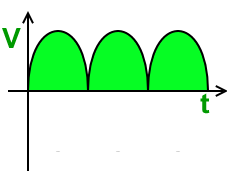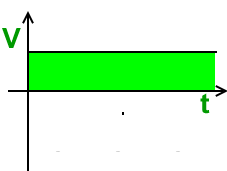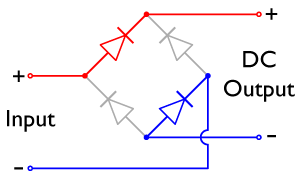Power Adapters
Here's a video that explains and demonstrates how a basic AC adapter works. (Link to same video hosted on YouTube.)
Here's the schematic diagram of the basic AC adapter.




| This is what the input voltage to the AC adapter looks like. The output of the transformer looks the same, only with smaller peak voltage. | This is the output of the rectifier bridge, if the smoothing capacitor wasn't present. | This is the smooth output, thanks to the capacitor. (image source: Wikimedia Commons) |
How does the bridge rectifier work?
You can think of a diode as a switch, that turns itself on (conducts) when the anode (the wire at the blunt end of the diode symbol) is more positive than the cathode (the pointy end of the diode symbol). The input wires of the rectifier bridge, coming from the transformer, are alternating in polarity. The first diagram below shows a particular moment when the top input wire is positive and the bottom input wire is negative. At this moment, the top-left and bottom-right diodes are conducting, because for these two diodes the anode is more positive than the cathode. The other two diodes are off, so the top input wire is connected to the top output wire. Half a period later (second diagram below), when the top input wire is negative and the bottom positive, the bottom-left and top-right diodes are the ones that are on. Now the top input wire is connected to the bottom output wire. The net result is that when the input switches polarity, the wire connecting to the output wires are swapped. The top output wire is always positive. (image source: Wikimedia Commons)


Additional Activities & Practice
1. Here is the label on an AC adapter. (a) What is the turns ratio of the transformer? (b) Does this have a rectifier or not? (c) What is the maximum power this thing can provide?
|

